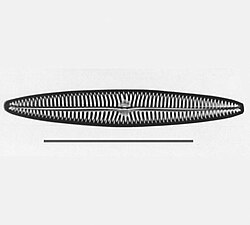| Navicula | |
|---|---|

| |
| Navicula bullata (left) | |
| Scientific classification | |
| Domain: | Eukaryota |
| Clade: | Diaphoretickes |
| Clade: | SAR |
| Clade: | Stramenopiles |
| Phylum: | Gyrista |
| Subphylum: | Ochrophytina |
| Class: | Bacillariophyceae |
| Order: | Naviculales |
| Family: | Naviculaceae |
| Genus: | Navicula Bory de Saint-Vincent, 1822 |
| Type species | |
| Navicula tripunctata | |
| Species | |
Navicula is a genus of boat-shaped diatom algae, comprising over 1,200 species.[1] Navicula is Latin for "small ship", and also a term in English for a boat-shaped incense-holder.[2]
Diatoms — eukaryotic, primarily aquatic, single-celled photosynthetic organisms — play an important role in global ecology, producing about a quarter of all the oxygen within Earth's biosphere, often serving as foundational organisms, or keystone species in the food chain of many environments where they provide a staple for the diets of many aquatic species.
Mobility[edit]
Navicula diatoms have been observed to possess a motile ability to glide over one another and on hard surfaces such as microscope slides.[3][4][5] Around the outside of the navicula's shell is a girdle of mucilage strands that can flow and thus act as a tank track.[6]
-
Lyrella hennedy
-
Navicula oblonga
-
Navicula oblonga
References[edit]
- ^ M.D. Guiry (2015). Guiry, M.D.; Guiry, G.M. (eds.). "AlgaeBase". World-wide electronic publication, National University of Ireland, Galway. Retrieved 2015-08-15.
- ^ Oxford English Dictionary, "Navicula. 3"
- ^ Navicula Diatom: Youtube video
- ^ Gupta, S; Agrawal, SC (2007). "Survival and motility of diatoms Navicula grimmei and Nitzschia palea affected by some physical and chemical factors". Folia Microbiol (Praha). 52 (2): 127–34. doi:10.1007/BF02932151. PMID 17575911. S2CID 20030370.
- ^ J Microbiol Methods. 2013 Mar;92(3):349-54. doi: 10.1016/j.mimet.2013.01.006. Epub 2013 Jan 18. Semi-circular microgrooves to observe active movements of individual Navicula pavillardii cells. Umemura K1, Haneda T, Tanabe M, Suzuki A, Kumashiro Y, Itoga K, Okano T, Mayama S.
- ^ Chen, Lei; Weng, Ding; Du, Chuan; Wang, Jiadao; Cao, Shan (14 May 2019). "Contribution of frustules and mucilage trails to the mobility of diatom Navicula sp". Scientific Reports. 9 (1): 7342. Bibcode:2019NatSR...9.7342C. doi:10.1038/s41598-019-43663-z. PMC 6517400. PMID 31089153.
External links[edit]
- Navicula Image (Missouri State University)
- Navicula sp. Diatoms from Guaíba island, Rio de Janeiro.
- Bacillariophyceae - Navicula Ohio University
- "Navicula". WoRMS. World Register of Marine Species.
 Media related to Navicula at Wikimedia Commons
Media related to Navicula at Wikimedia Commons





Well, that’s interesting to know that Psilotum nudum are known as whisk ferns. Psilotum nudum is the commoner species of the two. While the P. flaccidum is a rare species and is found in the tropical islands. Both the species are usually epiphytic in habit and grow upon tree ferns. These species may also be terrestrial and grow in humus or in the crevices of the rocks.
View the detailed Guide of Psilotum nudum: Detailed Study Of Psilotum Nudum (Whisk Fern), Classification, Anatomy, Reproduction